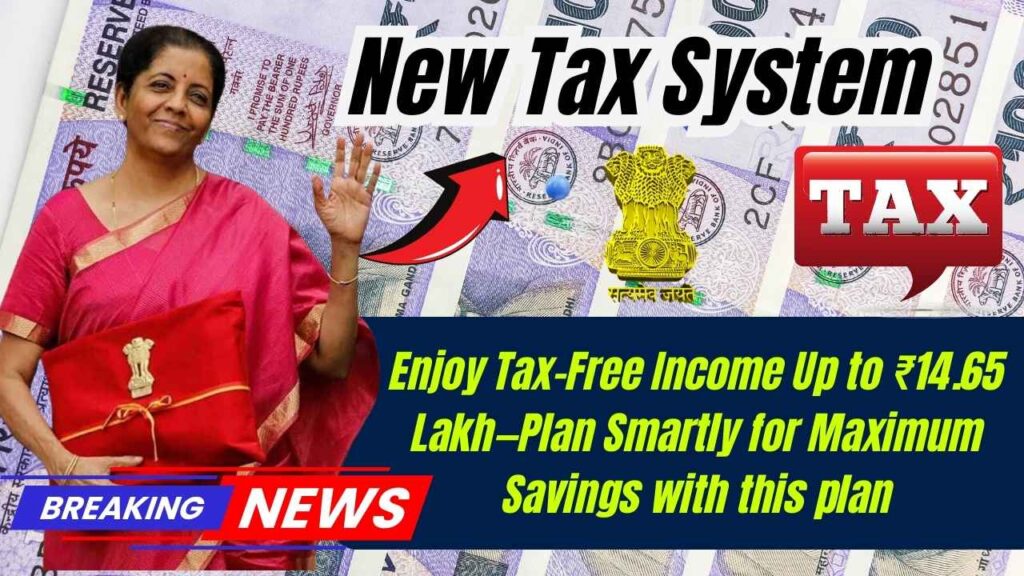New Tax System – New Tax System: Enjoy Tax-Free Income Up to ₹14.65 Lakh – The Indian government has introduced a major update to the income tax regime, allowing individuals to earn up to ₹14.65 lakh annually without paying any income tax. This policy shift aims to enhance disposable income, encourage savings, and fuel economic growth.

If you want to maximize your tax savings and make the most of this new opportunity, keep reading! This article will break it down into simple, easy-to-understand steps while ensuring professionals get the detailed insights they need.
New Tax System
| Feature | Details |
|---|---|
| Tax-Free Income Limit | Up to ₹12 lakh completely tax-free, can be extended to ₹14.65 lakh with deductions |
| Standard Deduction | ₹75,000 under the new tax regime |
| Additional Deductions | Up to ₹1.5 lakh under Section 80C, plus ₹50,000 under Section 80CCD(1B) (NPS) |
| Employer Contribution to NPS | Up to 14% of basic salary is tax-exempt under Section 80CCD(2) |
| Effective Tax Planning | Utilizing salary structuring and deductions to legally eliminate tax liability |
The government’s new tax framework offers salaried individuals an incredible opportunity to enjoy zero tax liability on income up to ₹14.65 lakh by optimizing deductions and structuring their salary smartly. By leveraging the standard deduction, Section 80C investments, and NPS contributions, you can legally eliminate your tax burden.
Key Takeaways:
- The new system makes tax-saving simpler and more efficient.
- With smart salary structuring and investments, you can ensure maximum tax-free income.
- Stay updated with tax law changes to optimize your financial strategy.
Understanding the New Tax-Free Income Structure
Earlier, taxpayers had to carefully navigate deductions and exemptions to reduce their tax liability. However, the 2025 Union Budget has provided a streamlined tax-free income opportunity.
- Base Tax-Free Income: Under the new tax system, individuals with an annual income of up to ₹12 lakh owe zero tax.
- Additional Deductions: By leveraging standard deductions and National Pension System (NPS) contributions, this threshold can be increased to ₹14.65 lakh.
How to Reach the ₹14.65 Lakh Tax-Free Income Limit?
1. Standard Deduction (₹75,000)
The standard deduction applies to all salaried employees and pensioners, allowing a flat reduction of ₹75,000 from taxable income.
Example: If your salary is ₹12 lakh, after subtracting the standard deduction, your taxable income reduces to ₹11.25 lakh.
2. Maximize Section 80C Benefits (₹1.5 Lakh)
Section 80C allows individuals to claim tax deductions up to ₹1.5 lakh by investing in:
- Employee Provident Fund (EPF)
- Public Provident Fund (PPF)
- Life Insurance Premiums
- Equity-Linked Savings Scheme (ELSS)
- National Savings Certificate (NSC)
3. National Pension System (NPS) Benefits (₹50,000 – ₹1.5 Lakh)
NPS contributions provide additional tax relief:
- Self-Contribution (Section 80CCD(1B)): Additional ₹50,000 can be claimed separately.
- Employer Contribution (Section 80CCD(2)): If your employer contributes up to 14% of your basic salary to NPS, this amount is fully exempt from tax.
Example Calculation: If your basic salary is ₹6 lakh, your employer can contribute up to ₹84,000 tax-free under this provision.
4. Health Insurance and Medical Expenses (Section 80D)
An additional deduction of up to ₹25,000 can be claimed for health insurance premiums paid for self, spouse, and children. If parents are also covered under a separate policy, an additional ₹50,000 can be deducted for their premiums.
5. Home Loan Interest Deduction (Section 24B & Section 80EEA)
- Section 24B: Deduct up to ₹2 lakh on interest paid on a home loan.
- Section 80EEA: Additional deduction of ₹1.5 lakh for first-time homebuyers.
6. Leave Travel Allowance (LTA) & House Rent Allowance (HRA)
For salaried employees, LTA and HRA provide tax benefits when structured correctly. Keep all travel and rent receipts for maximum deductions.
A Step-By-Step Tax Saving Plan
Step 1: Structure Your Salary Smartly
Ensure that your salary components include maximum allowances and NPS contributions to take advantage of tax benefits.
Step 2: Invest in Tax-Saving Instruments
- Max out Section 80C investments
- Utilize Section 80CCD(1B) for NPS contributions
- Invest in health insurance (Section 80D)
Step 3: Verify Employer Contributions to NPS
- Request your HR to allocate a portion of your salary as NPS employer contribution
Step 4: Keep an Eye on Budget Updates
- Stay updated with changes in income tax slabs and deductions to optimize savings.
Big Tax Relief for Seniors! How the New TDS Limits Help You Keep More Money
Big Change: Income Tax Bill 2025 to Tax Farming & Dairy Earnings!
New Tax Regime 2025 – Check New Income Tax Slab for AY 2025-26
FAQs
1. Who is eligible for the new tax-free income limit?
All salaried individuals opting for the new tax regime can enjoy this tax exemption.
2. Can I still claim deductions under the old tax regime?
No, this benefit is exclusive to the new tax regime. The old regime allows exemptions but has a higher tax burden.
3. Does this apply to business owners and freelancers?
Business owners and freelancers can claim some deductions, but the ₹14.65 lakh tax-free benefit is mainly for salaried employees.
4. What if I don’t invest in NPS?
Without NPS investments, your tax-free income will be capped at ₹12 lakh.







